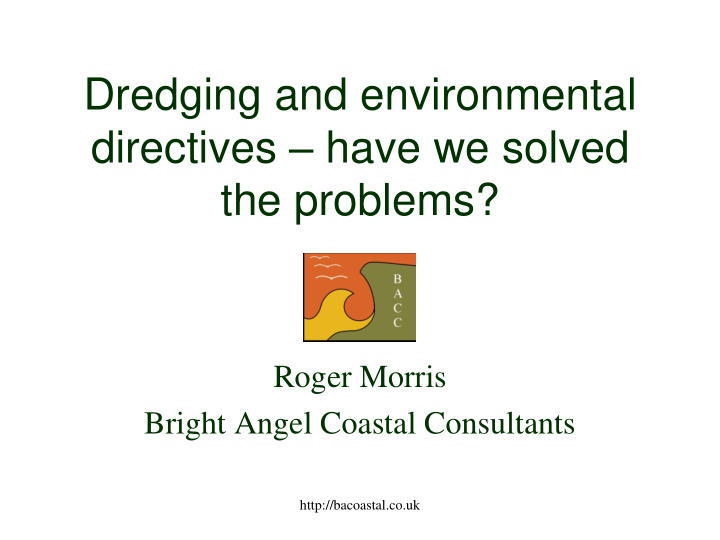



Dredging and environmental directives – have we solved the problems? Roger Morris Bright Angel Coastal Consultants http://bacoastal.co.uk
What does dredging do? • Deepening changes the energy regime. • Can change tidal propagation. • Removes sub-tidal animal and plant communities. • Creates a sink for suspended sediment. • Creates sediment plumes - potentially affecting BOD. • Creates underwater noise. http://bacoastal.co.uk
Impacts on wildlife • Reduces sediment availability. • Changes levels of inter-tidal exposure. • Removes certain habitats. • Smothers some habitats such as biogenic reefs • Impacts upon water quality: • Mobilises sediments, affecting BOD. • Re-mobilises contaminants. • Affects fish movement. http://bacoastal.co.uk
Reduced sediment availability • Dredging leads to a requirement for maintenance dredging. • Maintenance dredging removes sediment that might otherwise be deposited on foreshores. • Reduced sediment load changes the relationship between deposition and erosion - erosion is countered to a lesser extent than previously. http://bacoastal.co.uk
We can predict changes to tidal propagation • Harwich Haven Capital dredge • Immediate loss of 4.5 ha of inter-tidal through reduced exposure. • Proposed Southampton Capital Dredge • Mixture of reduced exposure and increased exposure - less mud and more sand • 1996 Southampton Capital Dredge • Illustrated how cut sediment could be used to provide a one-off foreshore replenishment. http://bacoastal.co.uk
Sediment loss = condition change • Sea level rise is affecting sedimentation - need more sediment to feed mudflats and saltmarshes. • Reduced sediment load = potential for winnowing - system becomes sandier. This potentially changes in-fauna and bird carrying capacity. http://bacoastal.co.uk
Sub-tidal habitat loss • Rarely an issue for Natura 2000. • But, Falmouth is an exception. • But, potentially an issue under the WFD: • Loss of extent of habitat. • Increase in extent of modification (shift from Unmodified to heavily modified = shift away from GEC). http://bacoastal.co.uk
Is dredging a Habitats Regulations issue? • YES • Loss of extent. • Changes to foreshore evolution - erosion. • Possible impacts on some sub-tidal habitats (e.g. maerl). • Possible impacts on protected species, especially Atlantic Salmon. http://bacoastal.co.uk
WFD Impacts • Changes to hydromorphology • Changes extent of modification • Impacts on water quality • Impacts on fish • Loss of biological assemblages http://bacoastal.co.uk
Do we have solutions? • YES & NO • We understand sediment management issues. • We have no solution to loss of sub-tidal habitats or to some water quality problems. http://bacoastal.co.uk
Dredging solutions in the UK • Changes to tidal propagation can be measured and compensated for. • Reduced sediment loads can be offset …. • … or can they? • Timing can be varied ….. • … or can it? • Sub-tidal impacts will be re- colonised ….. • … or will they? http://bacoastal.co.uk
Are known solutions compatible with all the issues? • NO • Sediment feeding is compatible with geomorphological objectives (which in the UK have taken priority). • Sediment feeding is ok in muddy estuaries but not in clear-water estuaries. • Sediment feeding can have an impact on BOD and water quality, especially in clear water estuaries http://bacoastal.co.uk
What does this mean in real terms 1? • Techniques for sediment feeding may not be acceptable: • Rainbowing • Overspilling • Timing for sediment feeding may be confined to the wrong time of year. http://bacoastal.co.uk
What does this mean in real terms 2? • Some dredges are not compatible with EU Environmental Directives. • The impacts are most likely to be severe in clear-water estuaries. http://bacoastal.co.uk
What does this mean in real terms 3? • Port expansion may not be possible in some Atlantic coast locations. • Guidance on port development needs to be better differentiated between North Sea, Atlantic, Mediterranian, Baltic and Black Sea environments. http://bacoastal.co.uk
Some concluding thoughts • The arrival of the WFD re-introduces a new tension. • Some water quality objectives may not accord with N2k geomorphological objectives. • There is much more to do! http://bacoastal.co.uk
Recommend
More recommend